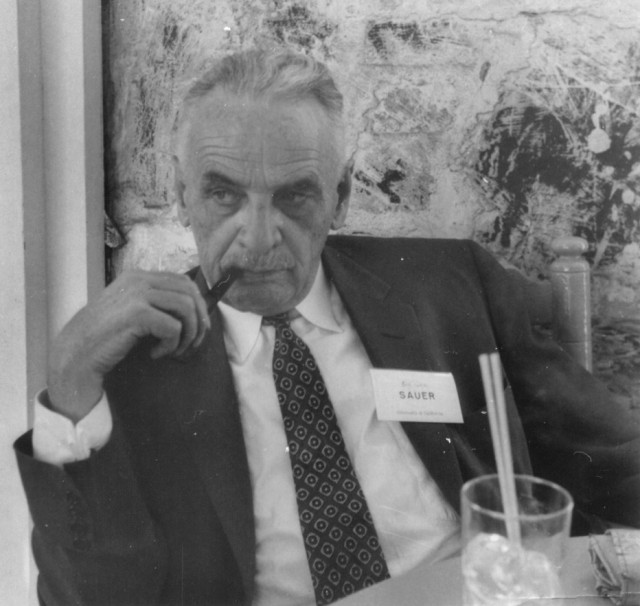Sauer, Carl O. (1889–1975)
CARL ORTWIN SAUER was one of the most influential American geographers. Throughout his long and distinguished career, he shaped and fundamentally changed the field of cultural and anthropogeography in the UNITED STATES. Sauer was of German descent, and his ancestors were members of a German pietistic sect affiliated with the Methodists who had settled in Warrenton, MISSOURI, Sauer's place of birth.
After spending a few school years in Germany, he received an A.B. degree in 1908 from Central Wesleyan College in Warrenton. In 1915 Sauer obtained his Ph.D. from the University of Chicago, where he studied with R.D. Salisbury and Ellen Churchill Semple. The latter represented the American version of environmental determinism (also referred to as “environmentalism” or “geographic influences”), then the guiding principle of American geography. Although Sauer had enjoyed Semple's lectures at Chicago, he became increasingly dissatisfied with environmental determinism for it focused rigidly, solely, and in a Darwinian manner on the environmental influences on man.

After eight years at the University of Michigan where he became a full professor, Sauer accepted an appointment as professor of geography at the University of California, Berkeley. During his Berkeley years (1923–57), he elaborated the geography often referred to as the Sauer School or the Berkeley School. Although until the 1930s he was sympathetic to regional studies and in his early career he had carried out some studies in this tradition, Sauer expressed growing dissatisfaction with regional geography. Sauer criticized regional studies for their sole focus on the characterization of an area and claimed that they had no value for problem formulation and development of solutions.
To be sure, Sauer neither denied determinism nor did he entirely discard the regional method. But he considered these ways of doing geography to be all too mechanistic and with only limited value for explanation and problem formulation. Subsequently, he came up with his own landscapist view of geography, which regarded time to be the most important dimension of geography.
CULTURAL GEOGRAPHY
Henceforth, landscape was studied and observed from a historical and genetic perspective. Thus, Sauer's geographical studies were driven by an interest in historical processes and sequences and, moreover, by the aesthetic qualities of landscape. A central role was ascribed to the influences of culture as a shaping force, cultural processes and cultural products as agents of transformation of nature or as elements that give character to area. Sauerian geography of this kind was referred to as landscape morphology, culture history, and also CULTURAL GEOGRAPHY.
In his research, Sauer was predominantly concerned with rural areas, especially in MEXICO and South America. Furthermore, he was interested in geographical aspects of the life of prehistoric and native peoples. He had great respect for both rural and native life and showed no objections to moralist ethical evaluation: Sauer was distinctively critical of the destructive exploitation of land and life and showed a skeptical attitude toward applied geography in the service of profit economy. Part of Sauer's work was regarded as a “silent spring” of the ecological movement.
In the study of geography, Sauer stressed the importance of geographical inquiry based on observation. He was a fierce opponent of quantitative methods in geography and considered fieldwork and archive work as the main components for the practice and study of geography and was never tired of stressing the importance of independence and self-determination of the researcher. Until his death in 1975, Sauer was a resolute advocate and protector of the privileged status of geography as an unspecialized discipline with interdisciplinary character.